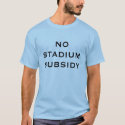Today I'd like to highlight one of those articles: Finding the Bottom Line for Sports: Observations from an Academic by Brad Humphreys. Humphreys has a Ph.D. in Economics, and he is currently an Associate Professor in the Department of Recreation, Sport and Tourism at the University of Illinois Urbana-Champaign.
This article is particularly relevant in light of next Tuesday's City Council meeting because Humphreys analyzes the differences between "economic impact studies," which are typically prepared by sports teams, and academic research, which centers on analyzing the costs and benefits of subsidies.
The staff analysis of the San Francisco 49ers' economic impact report will be one of the subjects at the next City Council meeting, and the issues Humphreys highlights should form an important part of that analysis.
While Humphreys acknowledges that the presence of a professional sports can offer some non-economic benefits "like civic pride and world-class city status for their host communities," he concludes that "these benefits don't seem to justify the public spending needed to build a 21st century stadium."
In fact, he states that
My own research, published in peer-reviewed academic journals, and based on past economic performance of all U.S. cities with a professional football, basketball or baseball franchise since 1969, concludes that professional sports teams and facilities increased employment and earnings in only one small sector of the economy -- the recreation and amusement industry. It actually reduced earnings and employment in related industries like hotels, bars and restaurants.
Overall, professional sports reduced real per-capita income in their metropolitan areas by about $40 per year.
If that information is true, you may wonder, then where does the economic impact report get its numbers?
Humphreys addresses this question in the article. He finds sports teams and supporters use economic impact studies, which are forecasts. He writes,
They use relatively simple methods to quantify complex economic events. There is no widely accepted standard methodology for generating these forecasts, so the authors face many choices in how to run these studies, ultimately affecting the size of expected benefits.
Academic research and analysis, on the other hand, . . .
. . . goes through the peer review process, and papers with important flaws in methodology, data or technique are typically not published. But peer-reviewed academic papers are not accessible to non-specialists, so reporters rarely see them. Researchers care about both the conclusions and how those conclusions were reached, so academic papers contain mathematical equations, long detailed methodological discussions, footnotes and citations.
Humphreys also identifies three important differences between economic impact studies and academic analysis.
First is the question of gross spending vs. net spending.
He acknowledges that people spend a lot of money at games and events, but he cautions that "all this spending is not new spending." Most people have a limited budget, and if they spend more on attending events, they will have less to spend for other purposes.
Second is the issue of "Concentrated Benefits, Diffuse Costs."
In a nutshell, economic impact studies focus on the economic activity generated at the stadium, but they ignore the more diffuse decline in activity in other areas of the city. In the case of Santa Clara, such costs are things like fewer patrons at the AMC Mercado on event days.
The third issue is forecast uncertainty.
Economic forecasts, like weather forecasts, are projections. Hopefully, they are good projections based on solid information, but because they are projections, they carry a degree of uncertainity. A good forecast will identify "that degree of uncertainty in an understandable way. Forecasts are not very useful without that estimate of uncertainty, and an omission of that suggests a false degree of accuracy."
The San Francisco 49ers' economic impact report does NOT identify the degree of uncertainty. In fact, it states that . . .
The report has been prepared to assist the 49ers in the assessment of the economic impacts and community benefits associated with the franchise and the proposed new Santa Clara stadium and should not be relied upon for any other purpose, or by any other person or entity.
And that may be the most telling statement in the whole report.

No comments:
Post a Comment